HP VDI for SMB on Windows Server 2012
Recently, HP together with Microsoft presented a description of the model, according to companies, of the virtualization environment for workstations (VDI) in the SMB segment - HP Client Virtualization Reference Architecture for Windows Server 2012. The server part of the solution is based on the HP ProLiant DL380p Gen8 running Windows Server 2012, and client - on HP thin clients . This entire set has been successfully tested under conditions simulating real loads.
In this post I want to introduce you to the test results and tell you why these components were chosen for the solution.
This year was very rich in technological announcements for both HP and Microsoft. Microsoft launched Windows Server '12 in Russia less than a month ago, and HP, since March, wave by wave updated the line of ProLiant servers for the Gen8 generation. And it’s quite clear that for the virtualization market that is emerging before our eyes, small companies want to offer the most advanced products so that the need for updating does not occupy customers for many years to come.
As in any similar pre-fabricated hardware and software solution, the HP Client Virtualization SMB Reference Architecture for Windows Server 2012 (for brevity we will call it CV for SMB for short ) pursued the following goals:
And in my opinion, all these goals have been achieved.
The server side - HP ProLiant DL380p Gen8 - is a powerful universal tool for many tasks. The advantage of this server for CV for SMB tasks is the wide range of options for selecting / enhancing the hardware configuration.

A little bit about the server can be read here .
The client side - HP thin clients
As part of the CV for SMB solution, it is recommended to use representatives of a wide range of HP thin clients (surprisingly, as yet not very well-known in the Russian market). Although, of course, anything can work on the client side - from the desktop to the tablet.
Smart Zero Thin Clients: HP All-in-One t410 , HP t410other. They use Power-over-Ethernet power technologies and give users all the benefits of a “zero” client, along with high performance and low cost. For example, they can find the CV for SMB host on the network themselves, support many protocols and can be reflashed on the fly without local intervention in the device settings.
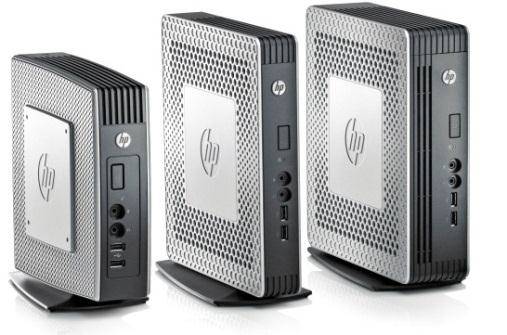
Flexible Thin Clients: the HP t510 , HP t610, or HP t610 Plus with Windows Embedded Standard 7 (WES 7) are ideal for customers who require advanced graphics capabilities. The top t610 Plus model stands out for its powerful CPU and GPU and PCIe slot, support for up to 4 displays, an internal WiFi antenna and Fiber NIC. Smart Zero Technologycan also be deployed on the Flexible series.
Solution Software - Windows Server 2012
This solution runs on Microsoft Windows Server 2012 and uses the Microsoft Remote Desktop Protocol (RDP) to provide remote desktop or remote application to the user. The virtualization function of the RemoteFX server video adapter allows you to provide users with remote access to the server video card capabilities. WS 2012 contains everything you need for VDI: connection broker, web access, gateway and other important components - all of them are integrated into Microsoft Windows Server 2012 as roles, so there is no need to purchase additional third-party products. In our case, the main advantages of Windows Server 2012 are:
HP CV SMB RA for Windows Server 2012 was tested by the Microsoft team using Login VSI v3.6 . The package imitates the real workload in a virtual environment: working with mail, texts, tables, creating slide shows, watching HD-video running on the server. For active sessions, we measured the response time for applications, CPU load, latency of the disk subsystem, and the length of the queue of I / O operations.
2 tests were conducted: initial and recommended.
The purpose of the initial test: to determine the maximum number of sessions that will create a load of not more than 80% of the CPU and will have a response time of not more than 3 seconds.
The team tested several scenarios: using Windows 7 and Windows 8 as the OS for end users and as the RDP 7 protocol.
The Microsoft team tested 250 users on a host server. Then, the limits were set for CPU utilization (80%) and response time (3sec), and the desired value of the maximum allowable number of sessions was revealed according to the schedule.
The results of the initial test with virtual machines on Windows 7.
Figure 1 shows the increase in load with an increase in the number of users, it was found that about 80 user logins were made within the load of 80% on the CPU. Chart 2 shows the disk subsystem latency setting in a Windows 7 environment. Chart 3 shows the length of the I / O wait queue.

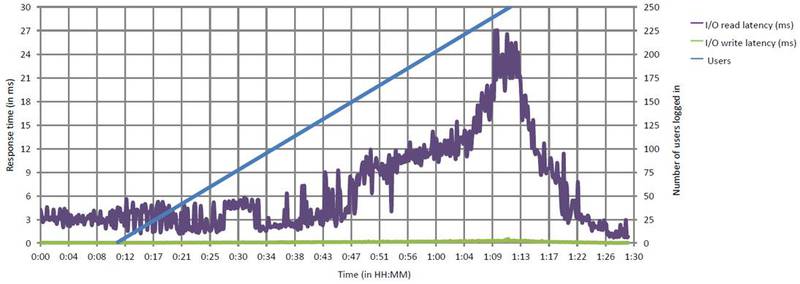

Graph 4 shows the response time. The initial limit was 879 milliseconds (ms), the maximum number of users was 239. After setting the threshold in 3 seconds, the number of user sessions was reduced to 230. The results of the initial test with virtual machines on Windows 8. Similarly, with the test on Windows 7, with a limit on the CPU utilization 80% of the results were obtained 175 user logins. Graph 6 shows the latency of the disk subsystem in a Windows 8 environment. Graph 7 shows the length of the I / O queue in Windows 8.


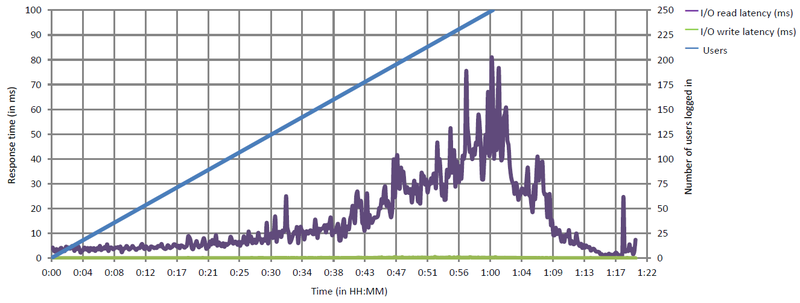
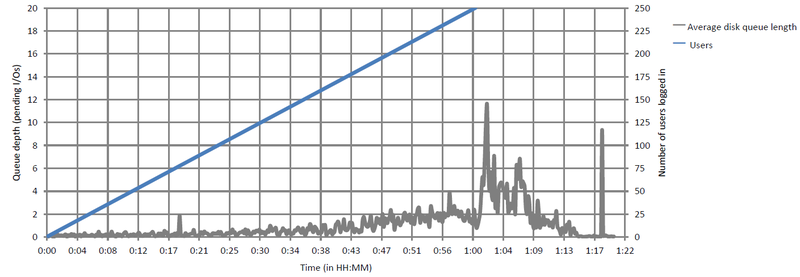
Graph 8 shows the response time of applications in Windows 8. The initial limit was 845 milliseconds (ms), the maximum number of users was 232. After setting the threshold in 3 seconds, the number of user sessions was reduced to 223.
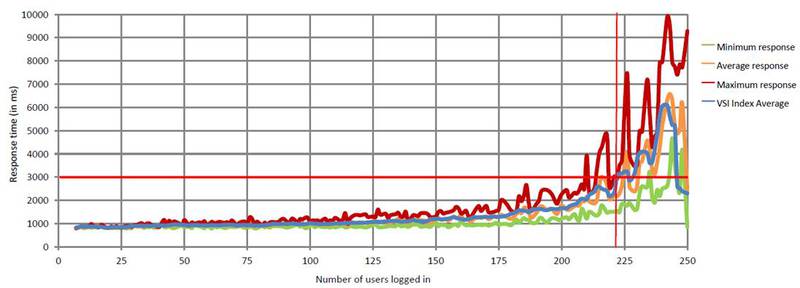
The recommended testing used 2 VDI host servers, one connection broker, Windows 8 virtual desktops, RDP 7. The result of the test was a system capable of processing 350 virtual desktops (pooled desktops) with 175 users on each host server. For this configuration, the User Profile Disk feature has been enabled which manages user profiles and application data.
In the benchmark, user data and profiles were located in different file shares. The connection broker for remote desktop connections was located on a virtual machine (4 cores, 8 GB RAM). In addition, the NLA was fully entrusted with the task of routing and assigning virtual machines to users.
Graph 9 shows an increase in application response time with the number of connected users.

It seems to me that the HP CV SMB RA for Windows Server 2012 shows impressive VDI performance results, and you can use this post as a guide to VDI calculations. Without extra costs - this is a very practical solution for small and medium-sized businesses. As always, I will be happy to answer your questions in the comments.
In this post I want to introduce you to the test results and tell you why these components were chosen for the solution.
This year was very rich in technological announcements for both HP and Microsoft. Microsoft launched Windows Server '12 in Russia less than a month ago, and HP, since March, wave by wave updated the line of ProLiant servers for the Gen8 generation. And it’s quite clear that for the virtualization market that is emerging before our eyes, small companies want to offer the most advanced products so that the need for updating does not occupy customers for many years to come.
As in any similar pre-fabricated hardware and software solution, the HP Client Virtualization SMB Reference Architecture for Windows Server 2012 (for brevity we will call it CV for SMB for short ) pursued the following goals:
- Maximum performance: The performance test described in detail below demonstrates that CV for SMB can support at least 175 virtual workstations per server with excellent response times.
- Convenience and low cost of deployment: the customer can be sure that the software is fully compatible with the hardware, and the cost of licenses is minimized due to OEM delivery. Designing a specific specification for your needs is easy, thanks to its scalability.
- All-inclusive: the solution does not need to deploy additional infrastructure - no management servers, database servers or SAN are needed. You also do not need to install additional virtualization or management software.
And in my opinion, all these goals have been achieved.
Let's consider the solution components in more detail:
The server side - HP ProLiant DL380p Gen8 - is a powerful universal tool for many tasks. The advantage of this server for CV for SMB tasks is the wide range of options for selecting / enhancing the hardware configuration.

A little bit about the server can be read here .
The client side - HP thin clients
As part of the CV for SMB solution, it is recommended to use representatives of a wide range of HP thin clients (surprisingly, as yet not very well-known in the Russian market). Although, of course, anything can work on the client side - from the desktop to the tablet.
Smart Zero Thin Clients: HP All-in-One t410 , HP t410other. They use Power-over-Ethernet power technologies and give users all the benefits of a “zero” client, along with high performance and low cost. For example, they can find the CV for SMB host on the network themselves, support many protocols and can be reflashed on the fly without local intervention in the device settings.

Flexible Thin Clients: the HP t510 , HP t610, or HP t610 Plus with Windows Embedded Standard 7 (WES 7) are ideal for customers who require advanced graphics capabilities. The top t610 Plus model stands out for its powerful CPU and GPU and PCIe slot, support for up to 4 displays, an internal WiFi antenna and Fiber NIC. Smart Zero Technologycan also be deployed on the Flexible series.
Solution Software - Windows Server 2012
This solution runs on Microsoft Windows Server 2012 and uses the Microsoft Remote Desktop Protocol (RDP) to provide remote desktop or remote application to the user. The virtualization function of the RemoteFX server video adapter allows you to provide users with remote access to the server video card capabilities. WS 2012 contains everything you need for VDI: connection broker, web access, gateway and other important components - all of them are integrated into Microsoft Windows Server 2012 as roles, so there is no need to purchase additional third-party products. In our case, the main advantages of Windows Server 2012 are:
- Effective management - RDS features in Windows Server 2012 are tightly integrated and can be easily configured in the new centralized console and in the wizards. Supported scenarios for working with pooled and with personal (dedicated) virtual desktops. In addition, the customer can automate the process of installing updates, which, together with the automation capabilities of server side management from HP, seriously saves the resources of an IT professional.
- RDS supports a variety of low-cost storage systems , eliminating the need for expensive SAN solutions. The customer can reduce the cost of the solution by moving configuration files and snapshots to “shared folders” (shared folders). Also, virtual machines can be stored on Cluster Shared Volumes (this is convenient when virtual machines that run from different nodes of the cluster are located on the cluster disk) and cached to the Direct Attached Storage disk subsystem, which provides high performance and low cost solutions.
- 3. The user can use all technologies that were previously difficult to implement in a virtual environment . For example, thanks to RemoteFX, 3D graphics and video streaming, USB redirection, and full support for touch devices and applications can be included. With the new User Profile Disk feature, it became possible to store user data and application cache data for pooled virtual machines and sessions, i.e. All data between user login sessions will be saved. By default, the system includes the dynamic distribution function of the CPU, network and I / O of the disk system, which prevents users from influencing the work of other users working on the same server.
Testing
HP CV SMB RA for Windows Server 2012 was tested by the Microsoft team using Login VSI v3.6 . The package imitates the real workload in a virtual environment: working with mail, texts, tables, creating slide shows, watching HD-video running on the server. For active sessions, we measured the response time for applications, CPU load, latency of the disk subsystem, and the length of the queue of I / O operations.
2 tests were conducted: initial and recommended.
The purpose of the initial test: to determine the maximum number of sessions that will create a load of not more than 80% of the CPU and will have a response time of not more than 3 seconds.
The team tested several scenarios: using Windows 7 and Windows 8 as the OS for end users and as the RDP 7 protocol.
Table 1. Host Server Specification for Both Tests
| HP ProLiant DL380p Gen8 Server |
| 2 CPU - Intel Xeon E5-2680 @ 2.70 GHz |
| 256 GB RAM, 16 GB DDR3 1333 MHz modules |
| 8 HDD 2 x 200 GB SSD SAS, RAID1 (for OS and "golden images") 6 x 300 GB 15K SAS, RAID5 (for virtual disks [VHDX]) |
| 4 x1 GB Ethernet (one port used in the test) |
Initial testing.
| Test tests | Login VSI V3.6, 15s interval between session starts |
Specifications | 8 virtual bootloaders (2 vCPU and 8 GB RAM each) |
User profiles | A single user profile has been configured for all virtual machines to reduce impact on IOPS and show processor limits |
Session | Resolution 1024x768. Without using connection broker and network level authentication (NLA) |
Virtual environment |
|
The Microsoft team tested 250 users on a host server. Then, the limits were set for CPU utilization (80%) and response time (3sec), and the desired value of the maximum allowable number of sessions was revealed according to the schedule.
The results of the initial test with virtual machines on Windows 7.
Figure 1 shows the increase in load with an increase in the number of users, it was found that about 80 user logins were made within the load of 80% on the CPU. Chart 2 shows the disk subsystem latency setting in a Windows 7 environment. Chart 3 shows the length of the I / O wait queue.



Graph 4 shows the response time. The initial limit was 879 milliseconds (ms), the maximum number of users was 239. After setting the threshold in 3 seconds, the number of user sessions was reduced to 230. The results of the initial test with virtual machines on Windows 8. Similarly, with the test on Windows 7, with a limit on the CPU utilization 80% of the results were obtained 175 user logins. Graph 6 shows the latency of the disk subsystem in a Windows 8 environment. Graph 7 shows the length of the I / O queue in Windows 8.




Graph 8 shows the response time of applications in Windows 8. The initial limit was 845 milliseconds (ms), the maximum number of users was 232. After setting the threshold in 3 seconds, the number of user sessions was reduced to 223.

Recommended Testing.
The recommended testing used 2 VDI host servers, one connection broker, Windows 8 virtual desktops, RDP 7. The result of the test was a system capable of processing 350 virtual desktops (pooled desktops) with 175 users on each host server. For this configuration, the User Profile Disk feature has been enabled which manages user profiles and application data.
Table 3. Test architecture reference architecture
| Test tests | Login VSI V3.6 at 5.14 intervals between parallel starts |
Specifications | 8 virtual bootloaders (2 vCPU and 8 GB RAM each) |
User profiles | Different types of users were used to connect to different types of virtual machines, user profiles were not preloaded and assigned to virtual machines; the disk capacity for the profile was set to 5 GB (dynamic). |
Session | Resolution 1024x768, NLA used; connection broker was fully involved in directing users to their respective virtual machines. |
Virtual environment | Windows 8, 32-bit, 1 vCPU, dynamic allocation of memory 768-1536 MB with 20% buffer, 1 NIC |
In the benchmark, user data and profiles were located in different file shares. The connection broker for remote desktop connections was located on a virtual machine (4 cores, 8 GB RAM). In addition, the NLA was fully entrusted with the task of routing and assigning virtual machines to users.
Graph 9 shows an increase in application response time with the number of connected users.

Conclusion
It seems to me that the HP CV SMB RA for Windows Server 2012 shows impressive VDI performance results, and you can use this post as a guide to VDI calculations. Without extra costs - this is a very practical solution for small and medium-sized businesses. As always, I will be happy to answer your questions in the comments.
